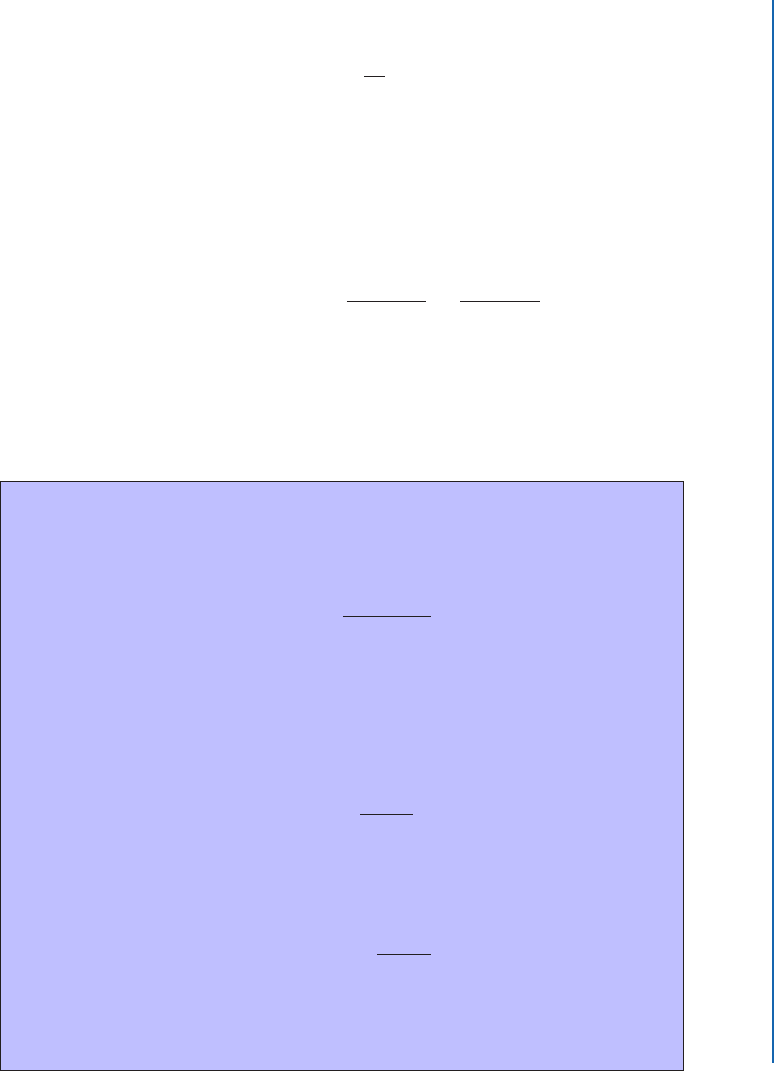
120 4. SEQUENCES, SERIES, AND FUNCTION APPROXIMATION
Knowledge Box 4.4
Arithmetic combinations of sequences
If fx
n
g has a limit of L, and fy
n
g has a limit of M , and if a; b are
constants, then:
• lim
n!1
ax
n
˙ by
n
D aL ˙ bM
• lim
n!1
x
n
y
n
D L M
• lim
n!1
x
n
y
n
D
L
M
if M ¤ 0.
• lim
n!1
x
k
n
D L
k
Example 4.5 Find the limit of
S D
x
n
D
1
n
C 3
n
n C1
W n D 1; 2; 3; : : :
Solution:
We already know the limit of 1=n, as a series, is zero. Using Knowledge Box 4.2 it is
easy to see that:
lim
n!1
n
n C1
D 1
Combining these results using the information in Knowledge Box 4.4 we get that the limit is:
L D 0 C 3 1 D 3
˙
is concludes our direct investigation of sequences. We now turn to using sequences as a tool
to explore series. Where a sequence is an infinite list of numbers, a series is an infinite list
of numbers that you add up. is may or may not result in a finite sum – and resolving that
question requires sequence theory.

4.1. SEQUENCES AND THE GEOMETRIC SERIES 121
Knowledge Box 4.5
Definition of series
If fx
n
W n D 0; 1; : : :g is a sequence, then
1
X
nD0
x
n
D x
0
C x
1
C C x
k
C
is the corresponding infinite series. If we sum only finitely many terms
we have a finite series.
Example 4.6 Show that the following infinite series sums to 1.
1
X
nD1
1
2
n
D
1
2
C
1
4
C
1
8
C
Solution:
1
2
1
4
1
8
1
16
etc.
1
1
Figure 4.1: A unit square cut into pieces 1/2, 1/4, 1/8, : : :
Examine Figure 4.1. e figure divides a unit square (with area 1) into rectangles of size 1/2,
1/4, 1/8, and every other number in the series we are trying to sum. is constitutes a geometric
demonstration that the series sums to 1.
˙

122 4. SEQUENCES, SERIES, AND FUNCTION APPROXIMATION
Clearly, finding a cool picture is not a general technique for demonstrating that a series has a
sum. Proving no such picture exists when the series fails to have a sum is even more impossible
– we need a more general theory.
Knowledge Box 4.6
e sequence of partial sums of a series
Suppose that S D
1
X
nD1
x
n
is a series. If we set
p
n
D
n
X
kD1
x
k
;
then fp
n
g is called the sequence of partial sums of S. We say that a
series converges to a sum L if and only if its sequence of partial sums
has L as a limit.
Example 4.7 Find the sequence of partial sums of the series in Example 4.6 and compute its
limit.
Solution:
Compute the first few members of the sequence of partial sums:
p
1
D 1=2
p
2
D 1=2 C1=4 D 3=4
p
3
D 1=2 C1=4 C 1=8 D 7=8
p
4
D 1=2 C1=4 C 1=8 C 1=16 D 15=16
Which is a clear pattern, and it is easy to see
p
n
D 1
1
2
n

4.1. SEQUENCES AND THE GEOMETRIC SERIES 123
is gives us the sequence of partial sums. Computing the limit we get:
lim
n!1
p
n
D lim
n!1
1
1
2
n
D 1 0 D 1
So we get the same sum using this more formal approach.
˙
At this point we need to call forward an identity from Fast Start Integral Calculus:
1 Cx C x
2
C x
n
D
x
nC1
1
x 1
D
1 x
nC1
1 x
is identity is one that is true for polynomials, but it also applies to summing a finite series.
Additionally, this formula can be used as the partial sum of a particular type of infinite series –
at least when its limit exists.
Knowledge Box 4.7
Finite and infinite geometric series
e polynomial identity in the text tells us, for a constant a ¤ 1, that:
n
X
kD0
a
k
D
a
nC1
1
a 1
:
is is the finite geometric series formula.
If jaj < 1, then the limit of the finite series gives us the infinite geo-
metric series formula:
1
X
nD0
a
n
D
1
1 a
:
Applying Knowledge Box 4.4 we also get that:
1
X
nD0
c a
n
D
c
1 a
for a constant c. e number a is called the ratio of the geometric series.

124 4. SEQUENCES, SERIES, AND FUNCTION APPROXIMATION
Example 4.8 Compute
1
X
nD0
3
5
n
Solution:
is is a geometric series with ratio a D 1=5. It has a leading constant c D 3. Applying
the appropriate formula we see that:
1
X
nD0
3
5
n
D
3
1 1=5
D
3
4=5
D
15
4
˙
PROBLEMS
Problem 4.9 Prove formally, using the definition of the limit of a sequence, that
f
cos.2 n/ W n D 0; 1; 2; : : :
g
converges to 1.
Problem 4.10 Prove formally, using the definition of the limit of a sequence, that
1
n
2
W n D 1; 2; 3; : : :
converges to 0.
Problem 4.11 Prove formally, using the definition of the limit of a sequence, that
n
n C1
W n D 0; 1; 2; : : :
converges to 1.
..................Content has been hidden....................
You can't read the all page of ebook, please click here login for view all page.
